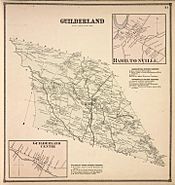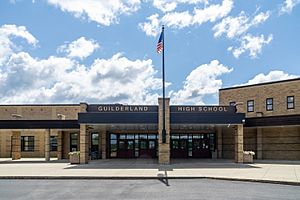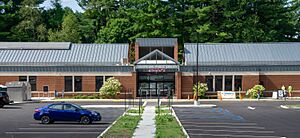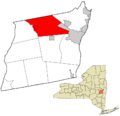Guilderland, New York facts for kids
Quick facts for kids
Guilderland
|
|
|---|---|
| Town of Guilderland | |
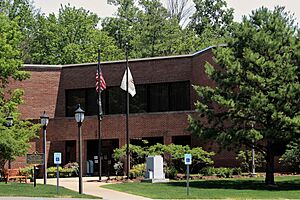
Guilderland Town Hall
|
|
| Etymology: Gelderland province in the Netherlands | |
| Motto(s):
Prospice Gelria - Latin for Look Forward Guilderland
|
|
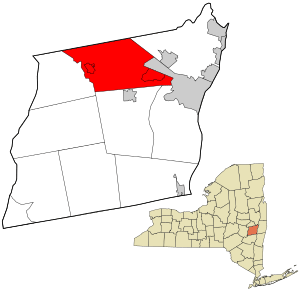
Location in Albany County and the state of New York.
|
|
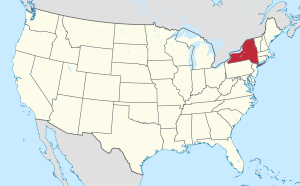
Location of New York in the United States
|
|
| Country | United States |
| State | New York |
| County | Albany |
| Settled | c. 1700 |
| Incorporation as town | 1803 |
| Area | |
| • Total | 58.79 sq mi (152.26 km2) |
| • Land | 57.90 sq mi (149.97 km2) |
| • Water | 0.88 sq mi (2.29 km2) |
| Elevation | 328 ft (100 m) |
| Population
(2020)
|
|
| • Total | 36,848 |
| • Density | 636.41/sq mi (245.70/km2) |
| Time zone | UTC-5 (EST) |
| • Summer (DST) | UTC-4 (EDT) |
| ZIP Code |
12084, 12303, 12009, 12203
|
| Area codes | 518,838 |
| FIPS code | 36-001-31104 |
| FIPS code | 36-31104 |
| GNIS feature ID | 0979030 |
| Wikimedia Commons | Guilderland, New York |
Guilderland is a town in Albany County, New York, United States. In 2020, about 36,848 people lived there. The town gets its name from the Gelderland province in the Netherlands.
Guilderland is located on the central-northwest side of Albany County. It is just west of Albany, which is the capital city of New York.
Contents
History of Guilderland
Guilderland was first part of the Manor of Rensselaerswyck. This large area was started in 1629 by Patroon Kiliaen van Rensselaer. It was part of the New Netherland colony.
By the late 1600s, Dutch settlers from Albany and Schenectady began to build farms here. They first settled along the Normans Kill river. In 1712, a group from the Rhine Valley in Germany passed through. They were the first to name the Helderberg Escarpment, calling it "Hellebergh," meaning "bright mountain." This name was also used for the land between the Normans Kill and the mountains.
The first religious service in Guilderland was held in 1734. It was for the "Normanskill Folk." The first church building was a Dutch Reformed Church, built in 1750.
Early Industries and Growth
Guilderland was a good place for early industries. It had many streams for waterwheels and large forests for wood. It also had fine sand, which was good for making glass.
In 1795, Jan and Leonard de Neufville started a big glass factory. They mostly made windows, but also bottles. The small town of Hamilton (now called Guilderland) grew around this factory. After the War of 1812, the factory could not compete with cheaper goods from Britain. It closed down, and the glass industry never returned to Guilderland. Other businesses, like a hat factory, later used the site. French's Mills, another early settlement, had many textile mills. These mills used the power from the Normans Kill falls.
Guilderland During the American Revolution
During the US Revolutionary War, families in Guilderland had different loyalties. Some supported the American rebels (Patriots), while others stayed loyal to the British (Loyalists). In New York, many tenant farmers often disagreed with their landlords, who were usually Patriots. This made the war in New York a difficult civil war.
The local leaders and clergy in Guilderland mostly supported the Patriots. Some Loyalists hid in the caves of the Helderbergs. They would raid settlements, sometimes with help from Native Americans. A battle happened just east of Guilderland Center. American forces won this battle. This victory allowed Rhode Island troops to join the Battle of Saratoga five weeks later. The Battle of Saratoga was a major turning point in the American Revolution.
Becoming a Town
From 1799 until 1803, Guilderland was part of the town of Watervliet. In 1803, Guilderland became its own town. The name "Guilderland" was suggested by Jeremiah Van Rensselaer. He was the Lieutenant-Governor of New York at the time. His family and many early settlers came from Gelderland, a province in the Netherlands.
In 1871, a part of Albany was added to Guilderland. Later, in 1910, some of this land was given back to Albany. This helped set up the town's current borders.
The Schoolcraft Family
The Schoolcraft family was very important when Guilderland was founded. John L. Schoolcraft was born in Guilderland in 1806. His grandfather, John Schoolcraft, raised him. The elder John Schoolcraft was wealthy and owned much property in Guilderland. He was the first Justice of the Peace, a church leader, and a member of the first school board.
John L. Schoolcraft became a successful businessman. He was president of Albany Commercial Bank (now part of Key Bank). He also became a politician and was elected to Congress in 1848. In the 1840s, he built the John Schoolcraft House, a Gothic mansion. He used it as a summer home.
Historic Sites
Guilderland has 37 places listed on the U.S. National Register of Historic Places. These are important historical sites. Some examples include:
- Albany Glassworks Site
- Altamont Historic District
- Hamilton Union Presbyterian Church
- John Schoolcraft House
- St. Mark's Lutheran Church
Guilderland was also home to the New York Power Pool's control center. This center managed electricity for New York State. Most of its work moved to the NYISO in 1999.
Geography
Guilderland covers about 58.7 square miles (152.26 square kilometers). Most of this area is land, with a small part being water.
Neighboring Areas
The town borders Schenectady County to the north and west. This includes the towns of Princetown and Rotterdam. Guilderland also borders the towns of Berne, Colonie, Bethlehem, and New Scotland. The city of Albany is also a neighbor.
Roads and Highways
Two major interstate highways, I-87 and I-90, pass through Guilderland. They meet in Albany, just north of Crossgates Mall. US 20 also runs through the town.
 |
Schenectady County Town of Princetown |
Schenectady County Town of Rotterdam |
Town of Colonie |  |
| Town of Knox | City of Albany | |||
| Town of New Scotland Village of Voorheesville/ |
Town of Bethlehem Hamlet of North Bethlehem |
Population and People
| Historical population | |||
|---|---|---|---|
| Census | Pop. | %± | |
| 1810 | 2,476 | — | |
| 1820 | 2,270 | −8.3% | |
| 1830 | 2,742 | 20.8% | |
| 1840 | 2,790 | 1.8% | |
| 1850 | 3,279 | 17.5% | |
| 1860 | 3,246 | −1.0% | |
| 1870 | 3,132 | −3.5% | |
| 1880 | 3,459 | 10.4% | |
| 1890 | 3,606 | 4.2% | |
| 1900 | 3,530 | −2.1% | |
| 1910 | 3,333 | −5.6% | |
| 1920 | 3,117 | −6.5% | |
| 1930 | 4,394 | 41.0% | |
| 1940 | 5,522 | 25.7% | |
| 1950 | 7,284 | 31.9% | |
| 1960 | 16,710 | 129.4% | |
| 1970 | 21,208 | 26.9% | |
| 1980 | 26,515 | 25.0% | |
| 1990 | 28,764 | 8.5% | |
| 2000 | 34,045 | 18.4% | |
| 2010 | 35,303 | 3.7% | |
| 2020 | 36,848 | 4.4% | |
| U.S. Decennial Census | |||
In 2010, Guilderland had 35,303 people living in 14,205 homes. Most residents (86.21%) were White. About 7.49% were Asian, and 3.41% were African American. About 3.2% of the population was Hispanic or Latino.
About 31.6% of homes had children under 18. The average household had 2.40 people. The average family had 3.00 people.
The median age in Guilderland was 39 years old. About 24.1% of the population was under 18. About 13.2% were 65 or older.
The median income for a household was $58,669. For families, it was $68,472. About 4.1% of the population lived below the poverty line. Most workers (64.9%) were in the private sector. About 29.1% worked for the government.
Education in Guilderland
In 1812, Guilderland had eight small, one-room schoolhouses. The first high school in the town opened in Altamont in 1901. It was the only high school between Albany and Schoharie at that time.
In 1953, the Guilderland Central School District was formed. This happened when the eight smaller school districts joined together.
Guilderland School District
The Guilderland Central School District serves most of Guilderland. It includes:
- One high school: Guilderland High School
- One middle school: Farnsworth Middle School
- Five elementary schools: Guilderland Elementary, Pine Bush Elementary, Lynnwood Elementary, Altamont Elementary, and Westmere Elementary.
Some parts of Guilderland are served by other school districts. These include the Voorheesville Central School District and the Schalmont Central School District. The Mohonasen Central School District also serves some areas.
Communities in Guilderland
Guilderland has several smaller communities within its borders:
- Altamont – A village in the western part of town.
- Dunnsville – A small community in the northwest.
- Fort Hunter – A small community in the northern part of town.
- Fullers – A community northwest of Hartmans Corners.
- Guilderland – A community with the same name as the town. It was established in 1796.
- Guilderland Center – A community west of Guilderland hamlet.
- Hartmans Corners – A community northwest of Guilderland hamlet.
- McCormacks Corners – A location northwest of Guilderland hamlet.
- McKownville – A community near the eastern town line, close to Albany.
- Meadowdale – A community near the southern town line.
- Parkers Corners – A community in the northwestern part of town.
- Watervliet Reservoir – A large water reservoir north of Guilderland Center.
- Westmere – A community in the eastern part of town. It is a suburb of Albany.
Libraries
Guilderland has two libraries: the Guilderland Public Library and the Altamont Free Library. Both are part of the Upper Hudson Library System.
The Guilderland Public Library is on Western Avenue. It is a cultural center for the town. About 59% of Guilderland residents have library cards. The library's use has grown a lot. Since 1992, visits have almost doubled. The number of items borrowed has more than doubled.
The Altamont Free Library serves the Village of Altamont. It is a free library within the town of Guilderland.
Notable People from Guilderland
Many interesting people have connections to Guilderland:
- Evert Bancker (1665–1734) – A fur trader and former mayor of Albany.
- Jon Busch – A professional soccer player.
- Ze Frank – An artist and public speaker.
- Johnny Grabowski (1900–1946) – A baseball player and umpire.
- Victoria A. Graffeo – A judge.
- David Paterson – The former Governor of New York. He lived in Guilderland as a state senator.
- Joseph E. Persico – An author and speechwriter.
- Henry Ramsay (1808–1886) – A well-known civil engineer.
- Henry Schoolcraft (1793–1864) – A geologist, geographer, and expert on Native American cultures.
- William D. Veeder (1835–1910) – A politician.
Images for kids
See also
 In Spanish: Guilderland (Nueva York) para niños
In Spanish: Guilderland (Nueva York) para niños


